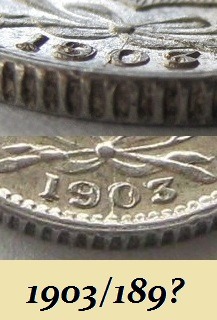Owner Comments:
General Comments:
Peru issued a short series of Standing and Seated Liberty coins now known as "transitionals" during the turbulent changeover to a decimal system. The Seated Liberty coins were also the first set of coins designed and engraved by Robert Britten, who was hired by the Peru mint from Britain to be Talla Abridor for the mint. The Seated 1/2 Real and Real can easily lay claim to being the precursor to the 1/2 Dinero and Dinero, respectively.
The 25 Centavo may be a different denomination and size to the forthcoming 1/5 Sols, but it is every bit the "Flying Eagle" to the "Indian Head Cent" of 1/5 Sols. The 25 Centavos is 6.25 grams at 25 cents, the 1/5 Sol 5 grams at 20 cents, both decimal weights. The reason why Peru decided to move from a 25 cent to 20 cent piece remains a mystery. The design of the 25 Centavos is largely similar to that of the 1863 1/5 Sol, mainly with differences of scale.
Minor varieties:
These are the three varities I've seen:
1. 9/8, period low in YB, close to laurel leaf
2. No overdate, period low in YB, low 9 in date
3. No overdate, period towards middle of YB
Flatt's listing is a bit confused, but he adds this
4. Period close to Y, large 5 in date, weakly clashed dies on Obverse.
Flatt reports that there is an Arabic 1/Roman 1 on the 9/8's.
Availability:
G-VF: Very scarce, available once or twice a year
XF-AU: Rare, available perhaps once a year
60-62: Rare
63-64: Rare, may take a couple years to find an Uncirculated specimen. While there are 6 graded, it's in high demand as a type coin, and is thus usually in strong hands.
Population Report (April 2016):
NGC: Three in 62; Two in 63; One in 64
PCGS: One in 45
Total at both services: 7; 6 in Uncirculated
Value Guide:
1972 Almanzar/Seppa: G: 12.50 VG: 20 F: 30 VF: 45 (Prices are for 1859/8, which the guide states all dates appear to be)
Current KM:
1859: VF: 85 XF: 175 UNC: 400
1859/8: VF: 65 XF: 155 UNC: 325
Although the 1972 guide doesn't even list a normal date, and KM values the overdate by 20 percent, my experience is that the plan date is more common, with about an even mix of low or middle period in Y.B. This is a difficult coin, and a one year type, I feel the prices in KM are fairly close to market. The prices for overdate versus plain date should probably be reversed though. Circulated coins do well in the market.
Auction Results:
Heritage 6/6/2006 NGC MS 63 $166.75 - The Whittier coin. Most Peru coins in this auction did poorly. This is the plate coin in KM.
Heritage 6/4/2007 NGC MS 62 $64 Cheap! But also very weakly struck in centers, kind of ugly, and eight years ago.
Heritage 4/16/2011 NGC MS 63 $1,495 (My coin. I did not pay this much!)
Heritage 4/18/2011 ANACS EF 40 9/8 $149.50
Sedwick 4/28/2011 NGC MS 63 $632.50 - Whittier Coin again.
Ebay 6/4/2011 VF, maybe light cleaning $20.50
Heritage 4/3/2012 NGC UNC Details Surface Hairlines $172.50
Ebay 11/13/2013 VF, ugly? $70.00
Lissner Sale 8/2015 NGC 64 $393.50 including BP
Set Specimen:
Tied with the Whittier coin as second finest known. One better in 64. The 64 is the Lissner coin, and from my experience, many of those coins graded at levels a bit better than they should have. That coin has dark spots on the center of the obverse, and was not stickered by WINGS. My coin has much reflectivity, featuring lightly mirrored fields with clashing on both the obverse and reverse. When held at an angle, a warm orange hue halos around the coin on each side, with a small area of rainbow oil-slick toning in the obverse exergue. Light scattered contact marks, none significant or distracting, determine the grade. From the Dana Roberts Collection. Heritage claims the weight to be 5.9 grams, rather than 6.25. They also note an "extraordinarily deep strike"

